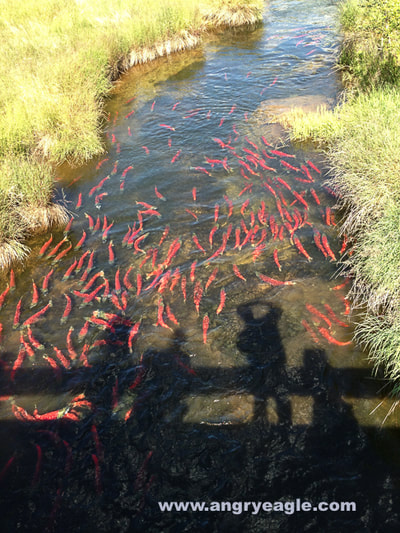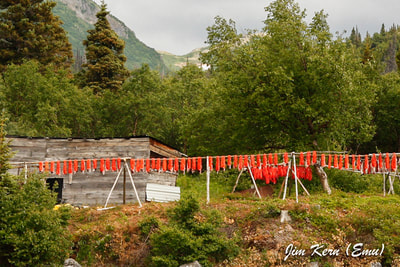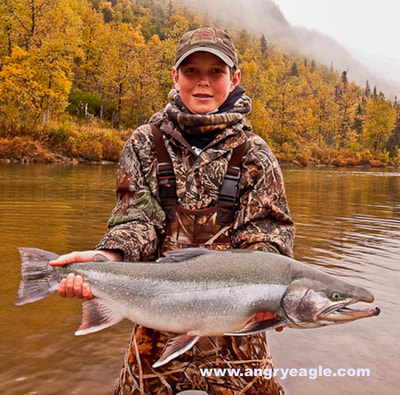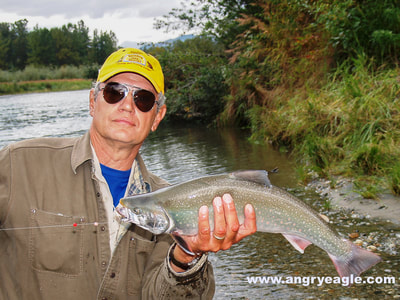|
The greatest salmon run in the world is currently in progress in southwest Alaska. The Alaska Department of Fish & Game has estimated that about 51 million Sockeye (Red) Salmon will leave the Bering and Pacific Oceans during the summer of 2018 to ascend the rivers of the mainland to spawn and die. Sockeye Salmon are considered the primo salmon for eating, be it canned, cooked or smoked. The indigenous peoples of coastal Alaska have for thousands of years taken and preserved vast numbers of Sockeyes during their annual summer spawning runs to feed their families and dog teams. The commercial fishermen will harvest over 20 million of the Sockeyes each year for the canneries and commercial market thereby leaving millions of to enter the lakes and streams for the bears, eagles, indigenous peoples and sport fishermen. The sport fisherman’s limit of Sockeyes is usually 5 per day, which means a couple of days of fishing can provide our clients with 30 or 40 lbs of one of the best eating filets you can find. Around the first week of July each yeaar, 4 – 6 million Sockeyes enter southwest Alaska’s vast Lake Iliamna from the Bering Sea making their way to the northeast end of the lake where Angry Eagle Lodge is located providing virtually an unlimited number of hookups for our clients through early September. If you have never experienced the awesome Sockeye runs of the Lake Iliamna area, you need to come visit us for one of the greatest spectacles of your life! We are now booking for the summer of 2019 and availability is limited during this popular time of the year, so it is advantageous to book your trip a year in advance to ensure you can have the dates you desire.
1 Comment
I have fished the Lake Iliamna and Lake Clark National Parks area of southwest Alaska since 1989 and managed Angry Eagle Lodge, formally Rainbow Bay Resort, for 6 years. This area of Alaska is known for its huge runs of the 5 species of Pacific Salmon and its big Rainbows, but the Arctic Char have held a special interest for me. You could call the Arctic Char a sub-species of Dolly Varden, as an Arctic Char is simply a land locked Dolly that does not have the ability to migrate back to the ocean. It takes a trained biologist examining a small bone in the cheek of the fish to determine if it is indeed an Arctic Char or a Dolly Varden. At the lodge we would catch true sea run Dolly Varden while fishing for Chum, Pink and Silver Salmon in the tributaries of Cook Inlet. Some of these Dollies would often be 30+ inches long weighing 10+ pounds, although most would be 15-20” long and weigh several pounds. These fish were normally caught on beads simulating salmon eggs, fished below the salmon which were near the surface ascending the streams to spawn. Occasionally you could catch them by skittering a Humpy or an Adams dry fly on the surface if there were not a lot of Salmon present. These Dolly Varden were dark gray on their backs, smoke gray on their sides and silver gray on their stomach with sometimes hard to see spots on their sides We would catch true Arctic Char in several Lakes in Lake Clark National Park where the Char were land locked. We were normally targeting these Char as well as the Lake Trout at the mouth of tributaries that flowed into the lake using streamers, spoons and spinners. These Char averaged 12 – 20” and usually weighed a couple of pounds as they were restricted mostly to a diet of their fry and Lake Trout fry in these diamond blue lakes created by melting snow from the surrounding mountains. These lakes were very deep, and structure was nothing but rocks and boulders providing a very stark landscape for the virtually nonexistent terrestrial insects. These fish could be spectacularly colored, sporting a light gray blue back, blue-silver sides with very distinct spots and a white belly. When they began to spawn their sides and belly would sometimes turn gold! The Char I enjoyed fishing for the most lived in tributaries to Lake Iliamna and in particular, the Iliamna river at the north end of the lake. Due to a huge die off of Char in the Iliamna river in the 1980’s, the river was designated a “Trophy Char River” in the early 1990’s meaning you could fish for the char, but you had to release all Char caught. Over the 30 years I fished as a client and guide for what is now Angry Eagle Lodge, formally Rainbow Bay Resort located at Pedro Bay on the north end of Lake Iliamna, I had the opportunity to watch the Char population blossom from the 12 – 14-inch Char we caught on the Iliamna River in the late 80’s to the huge 30-inch Char we are catching today. We learned a lot about how to catch these Char over the years. In the late 80’s we mainly used black 1/8th to 3/16th oz “Crappie jigs” very effectively for the smaller Char available at the time. After guiding for years and spending 3 – 4 days a week guiding on the Iliamna River we continued to use small black and light brown jigs and Clouser type flies to simulate the Sockeye smolt the Char were feeding on as the freshly hatched smolt would migrate in huge swarms from the Sockeye spawning grounds upriver down to Lake Iliamna where they would spend their first year. The Char would congregate in the deep holes of the river and feast on the smolt as the descended the river. Fishing with 6 – 8 lb line on ultra-light spinning tackle or 5 & 6 wt fly rods, it was not unusual to catch 30 – 40 Char in a day’s fishing in June. The Sockeye Salmon historically showed up at the north end of Lake Iliamna the end of the first week of June and began ascending the tributaries to the Illie as we referred to it, the end of the 2nd week of June. By that time most of the smolt had made their run down the Illie to the lake and the Char changed their eating habits from feasting on Sockeye smolt to feasting on the fresh Sockeye eggs and we accordingly changed our terminal tackle from small dark jigs and flies to bead patterns that simulated salmon eggs as using real salmon eggs was illegal. Fishing beads was a game of constant modification, as in mid to late June we used bright orange eggs, usually 6 or 8 millimeters in diameter to simulate freshly laid eggs from the spawning Sockeyes. By the 2nd week of July there were literally millions of Sockeye eggs in the river and it became a game of painting beads with light pink finger nail polish, modifying their appearance to look like eggs with the embryos beginning to mature or using light purple colored beads to simulate “dead” eggs. It was amazing as one day the Char and Rainbows would be taking bright orange eggs and the next day, or maybe just a run upstream the Char and Bows would be taking orange eggs with streaks of pink finger nail polish on them. It was an interesting game to find a bead coloring that would get the fish to hit your imitation instead of the millions of real eggs floating past them. When the fish really got stuffed in mid-August and I mean stuffed as when you would grab them around the mid-section to dislodge the hook they would regurgitate dozens of freshly consumed eggs, we would go to one say red 8 mm bead about 2 inches above the hook and a 6 mm painted orange bead a 1 ½ about the hook. The idea here was the red egg would attract the Char’s attention and he would hit the painted egg below the red egg. The idea may sound “fishy” but it often worked when nothing else would! Then by late August when the rivers were full of dead spawned out Sockeyes we would begin using pinkish tan or beige “flesh flies” that would simulate small chunks of decomposing Sockeye flesh. When nothing else would get the Char to hit we would bring out the 3 – 4” black or deep purple articulated leeches that simulated lamprey ells ascending the river to spawn. The Char I enjoyed fishing for the most lived in tributaries to Lake Iliamna and in particular, the Iliamna river at the north end of the lake. Due to a huge die off of Char in the Iliamna river in the 1980’s, the river was designated a “Trophy Char River” in the early 1990’s meaning you could fish for the char, but you had to release all Char caught. Over the 30 years I fished as a client and guide for what is now Angry Eagle Lodge, formally Rainbow Bay Resort located at Pedro Bay on the north end of Lake Iliamna, I had the opportunity to watch the Char population blossom from the 12 – 14-inch Char we caught on the Iliamna River in the late 80’s to the huge 30-inch Char we are catching today. We learned a lot about how to catch these Char over the years. In the late 80’s we mainly used black 1/8th to 3/16th oz “Crappie jigs” very effectively for the smaller Char available at the time. After guiding for years and spending 3 – 4 days a week guiding on the Iliamna River we continued to use small black and light brown jigs and Clouser type flies to simulate the Sockeye smolt the Char were feeding on as the freshly hatched smolt would migrate in huge swarms from the Sockeye spawning grounds upriver down to Lake Iliamna where they would spend their first year. The Char would congregate in the deep holes of the river and feast on the smolt as the descended the river. Fishing with 6 – 8 lb line on ultra-light spinning tackle or 5 & 6 wt fly rods, it was not unusual to catch 30 – 40 Char in a day’s fishing in June. The Sockeye Salmon historically showed up at the north end of Lake Iliamna the end of the first week of June and began ascending the tributaries to the Illie as we referred to it, the end of the 2nd week of June. By that time most of the smolt had made their run down the Illie to the lake and the Char changed their eating habits from feasting on Sockeye smolt to feasting on the fresh Sockeye eggs and we accordingly changed our terminal tackle from small dark jigs and flies to bead patterns that simulated salmon eggs as using real salmon eggs was illegal. Fishing beads was a game of constant modification, as in mid to late June we used bright orange eggs, usually 6 or 8 millimeters in diameter to simulate freshly laid eggs from the spawning Sockeyes. By the 2nd week of July there were literally millions of Sockeye eggs in the river and it became a game of painting beads with light pink finger nail polish, modifying their appearance to look like eggs with the embryos beginning to mature or using light purple colored beads to simulate “dead” eggs. It was amazing as one day the Char and Rainbows would be taking bright orange eggs and the next day, or maybe just a run upstream the Char and Bows would be taking orange eggs with streaks of pink finger nail polish on them. It was an interesting game to find a bead coloring that would get the fish to hit your imitation instead of the millions of real eggs floating past them. When the fish really got stuffed in mid-August and I mean stuffed as when you would grab them around the mid-section to dislodge the hook they would regurgitate dozens of freshly consumed eggs, we would go to one say red 8 mm bead about 2 inches above the hook and a 6 mm painted orange bead a 1 ½ about the hook. The idea here was the red egg would attract the Char’s attention and he would hit the painted egg below the red egg. The idea may sound “fishy” but it often worked when nothing else would! Then by late August when the rivers were full of dead spawned out Sockeyes we would begin using pinkish tan or beige “flesh flies” that would simulate small chunks of decomposing Sockeye flesh. When nothing else would get the Char to hit we would bring out the 3 – 4” black or deep purple articulated leeches that simulated lamprey ells ascending the river to spawn.
During the last 7 days, nearly 200,000 Salmon have ascended the Nushagak River in southwest Alaska fulfilling the our fishermen’s wildest dreams! These numbers include 32,000 King Salmon, 40,000 Sockeye Salmon and 124,000 Chum Salmon. Alaska Dept. of Fish & Game (ADF&G) officials expect the daily runs to subside somewhat during the next week as they open the season for commercial fishermen tomorrow off the mouth of the Nushagak in Bristol Bay. When escapement numbers are achieved in a given time frame, ADF&G gives the commercial industry window of time to net the incoming salmon until their wuoto numbers are met. This does not mean a total stop in the salmon entering the river, it simply cuts the numbers that enter the river daily. Any way you look at it, the last week has given the indication of a great salmon run for 2018! Angry Eagle Lodge flies it’s salmon fishermen early in the mornings from the lodge at Lake Iliamna to the Nushagak for a full day of fishing and then back to the comforts of our upscale lodge late in the afternoon. This allows our anglers to enjoy the great Salmon fishing on the Nushagak and not having to stay in a primitive tent camp on the River itself. After catching your yearly quota of 4 King Salmon, our ideal location on Lake Iliamna allows us to have our anglers experience the awesome Rainbow Trout, Arctic Char, Grayling and Pike fishing southwest Alaska offers as well as the great salmon fishing of the Nushagak River! Come visit us for the fishing experience of a lifetime as we are now booking for the 2019 fishing season.
|
Categories
AuthorWrite something about yourself. No need to be fancy, just an overview . Jim Kern has a long history in the Peacock Bass world. Jim has fished in Brazil 32 times since 1997 with both fly and conventional tackle. Jim developed and ran the American office for Captain Peacock from 2010 thru 2013 was the Vice President and General Manager of Amazon Tours from 1998 thru 2003. Through Emu Outfitting, his outfitting company of 30 years, he managed Alaska’s Rainbow Bay Resort from 2007-2009 & Alaska’s Angry Eagle Lodge 2013 & 2014. Jim holds a Coast Guard Captains license, has been a registered fishing guide in Alaska, Montana and Idaho and has been a fly tier for 40 years. Jim also was a 3 time American League All Star baseball pitcher in 1977, 78, and 79 & the American League Relief Pitcher of the year in 1979 Archives |
|
© COPYRIGHT 2015. ALL RIGHTS RESERVED.


























